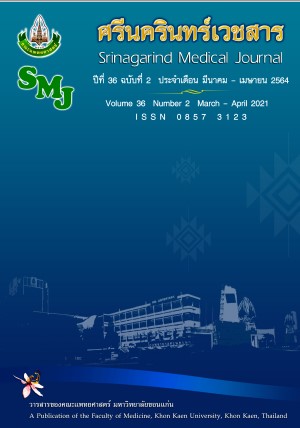ความชุกและอาการแสดงทางคลินิกของภาวะถุงน้ำรังไข่หลายใบในสตรีวัยรุ่น
Abstract
วัตถุประสงค์: เพื่อศึกษาความชุกของภาวะถุงน้ำรังไข่หลายใบในสตรีวัยรุ่นในระดับมัธยมปลายในจังหวัดขอนแก่น และอาการแสดงทางคลินิกของสตรีวัยรุ่นที่ได้รับการวินิจฉัยภาวะถุงน้ำรังไข่หลายใบ
วิธีการศึกษา: การศึกษานี้เป็นการศึกษาเชิงพรรณนาไปข้างหน้าในนักเรียนหญิงระดับมัธยมปลายในจังหวัดขอนแก่น อายุระหว่าง 15-18 ปี จำนวน 385 ราย โดยวินิจฉัยภาวะถุงน้ำรังไข่หลายใบตามเกณฑ์ของ The International Consortium of Pediatric Endocrinology (ICPE)
ผลการศึกษา: พบความชุกของภาวะถุงน้ำรังไข่หลายใบในสตรีวัยรุ่นร้อยละ 1.81 ความผิดปกติของประจำเดือนที่พบมากที่สุด คือ รอบประจำเดือนห่างผิดปกติ (Oligomenorrhea), สตรี 5 รายมีลักษณะทางคลินิกของฮอร์โมนเพศชายสูง เมื่อใช้การประเมินขนตามเกณฑ์ของ modified Ferriman-Gallwey scores และประเมินสิวที่ใบหน้า, สตรี 5 รายมีระดับฮอร์โมนเพศชายในเลือดสูง
สรุป: ความชุกของภาวะถุงน้ำรังไข่หลายใบในสตรีวัยรุ่นของการศึกษานี้ คือร้อยละ 1.81 โดยพบลักษณะประจำเดือนผิดปกติที่มากที่สุดคือ Oligomenorrhea และลักษณะทางคลินิกของฮอร์โมนเพศชายสูงพบได้เกือบทั้งหมดของผู้ที่ได้รับการวินิจฉัยภาวะถุงน้ำรังไข่หลายใบ
คำสำคัญ: ภาวะถุงน้ำรังไข่หลายใบ; ความชุก; วัยรุ่น; ฮอร์โมนเพศชายสูง; ประจำเดือนมาน้อย
Background and objective: This study was conducted to assess the prevalence and clinical features of polycystic ovary syndrome (PCOS) among high school-age Thai adolescents in Khon Kaen.
Materials and Methods: This was a cross sectional study in which 385 adolescents aged 15 to 18 years were enrolled. The diagnosis of PCOS was made according to the criteria issued by the International Consortium of Pediatric Endocrinology (ICPE).
Results: The prevalence of PCOS among participants was1.81%. Oligomenorrhea was the most common form of abnormal menstruation among participants with PCOS. Of the seven participants with PCOS, five had evidence of clinical hyperandrogenism according to their modified Ferriman-Gallwey scores, and two were noted as having clinical hyperandrogenism based on the presence of moderate acne vulgaris. Five of the seven participants with PCOS were found to have biochemical hyperandrogenism.
Conclusion: The prevalence of PCOS in the present study was 1.81%. The most common abnormal menstruation pattern among the patients with PCOS was oligomenorrhea. Clinical hyperandrogenism was noted in the majority of cases.
Keywords: Polycystic ovary syndrome; prevalence, adolescent; hyperandrogenism; oligomenorrhea


